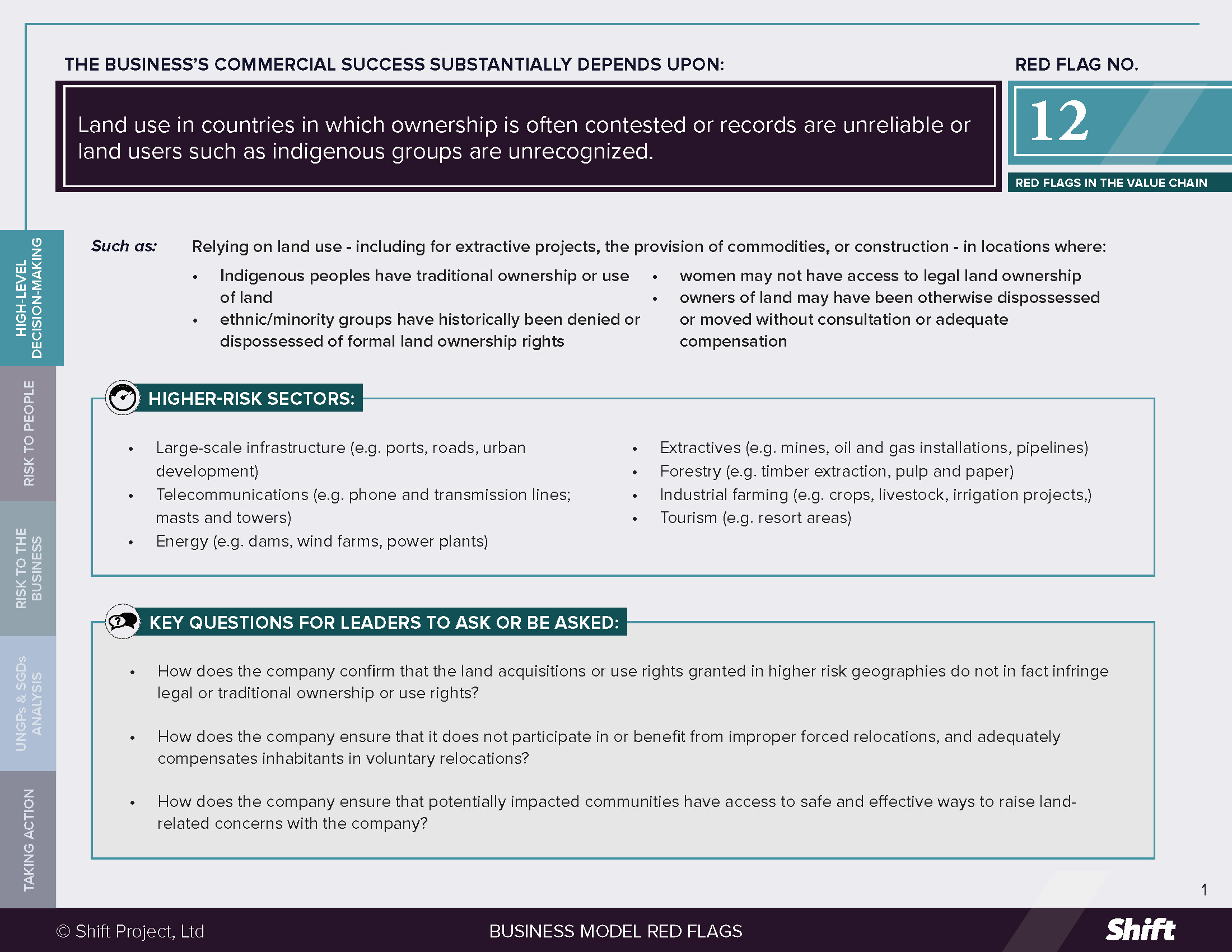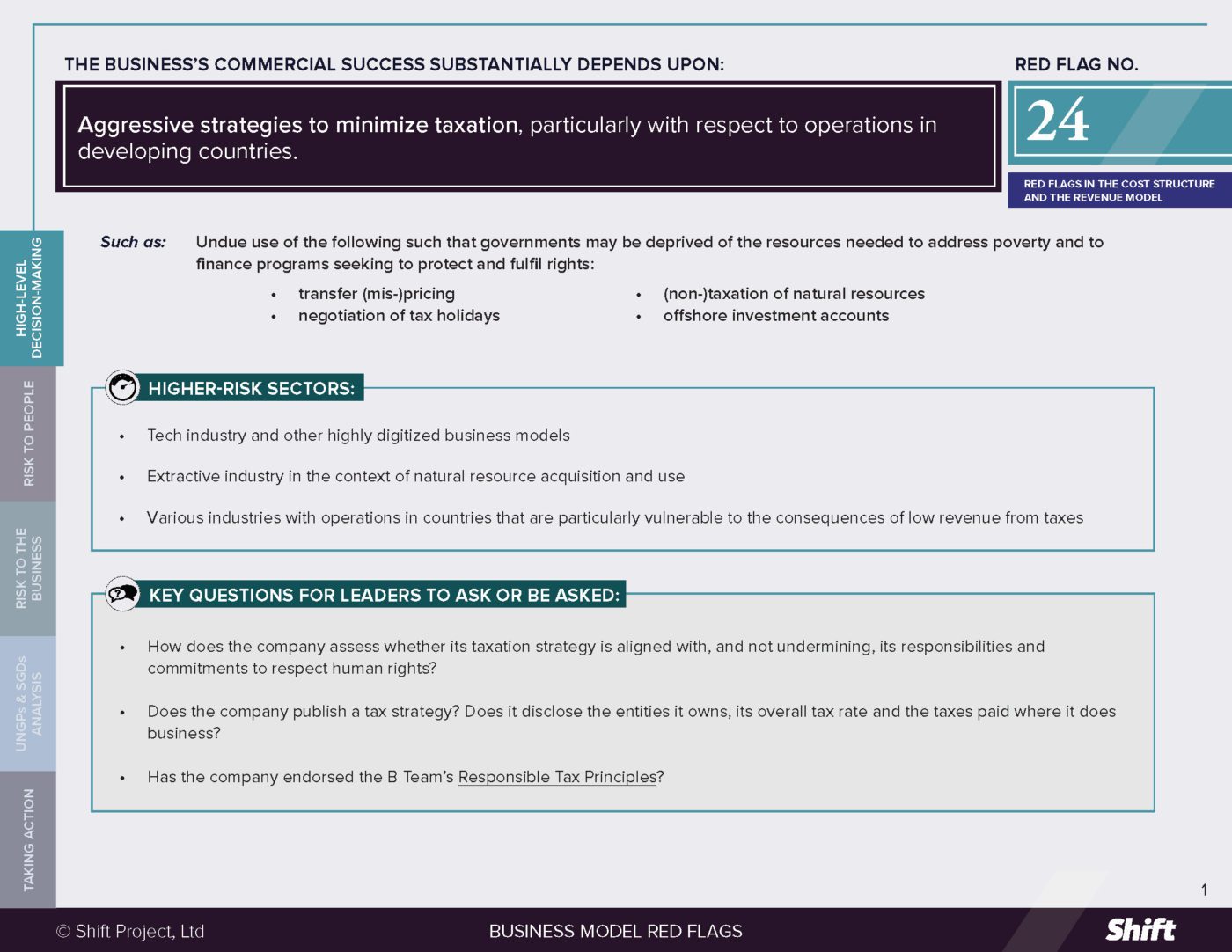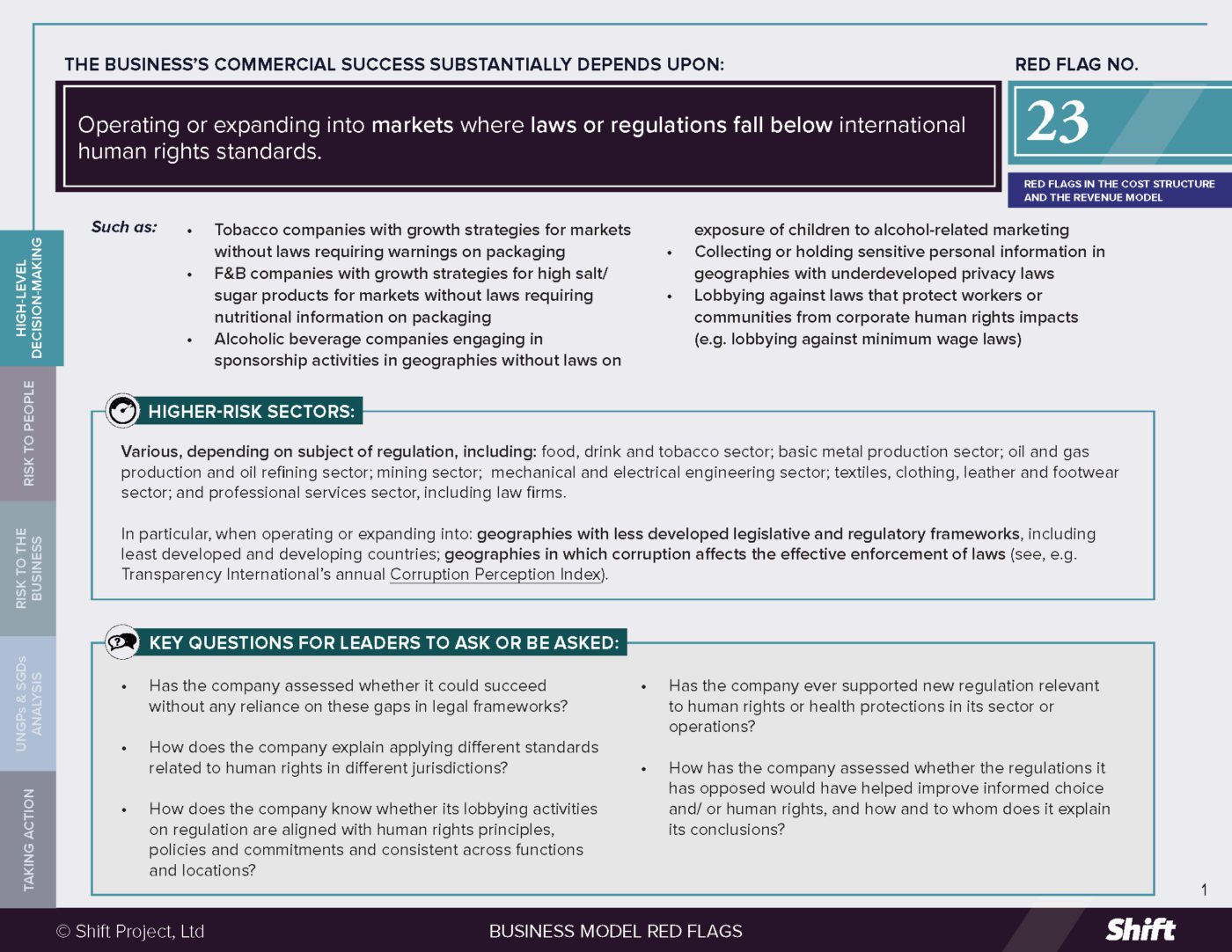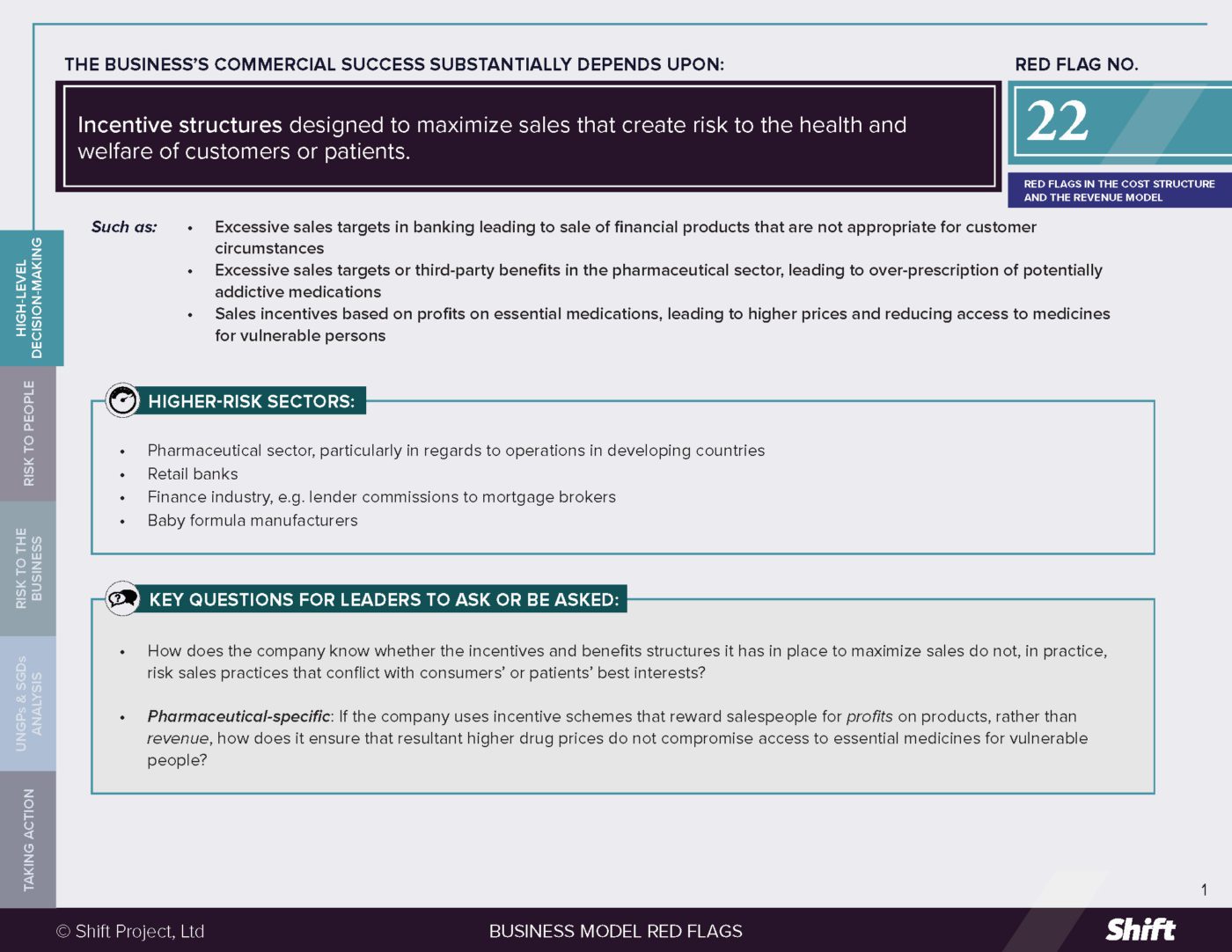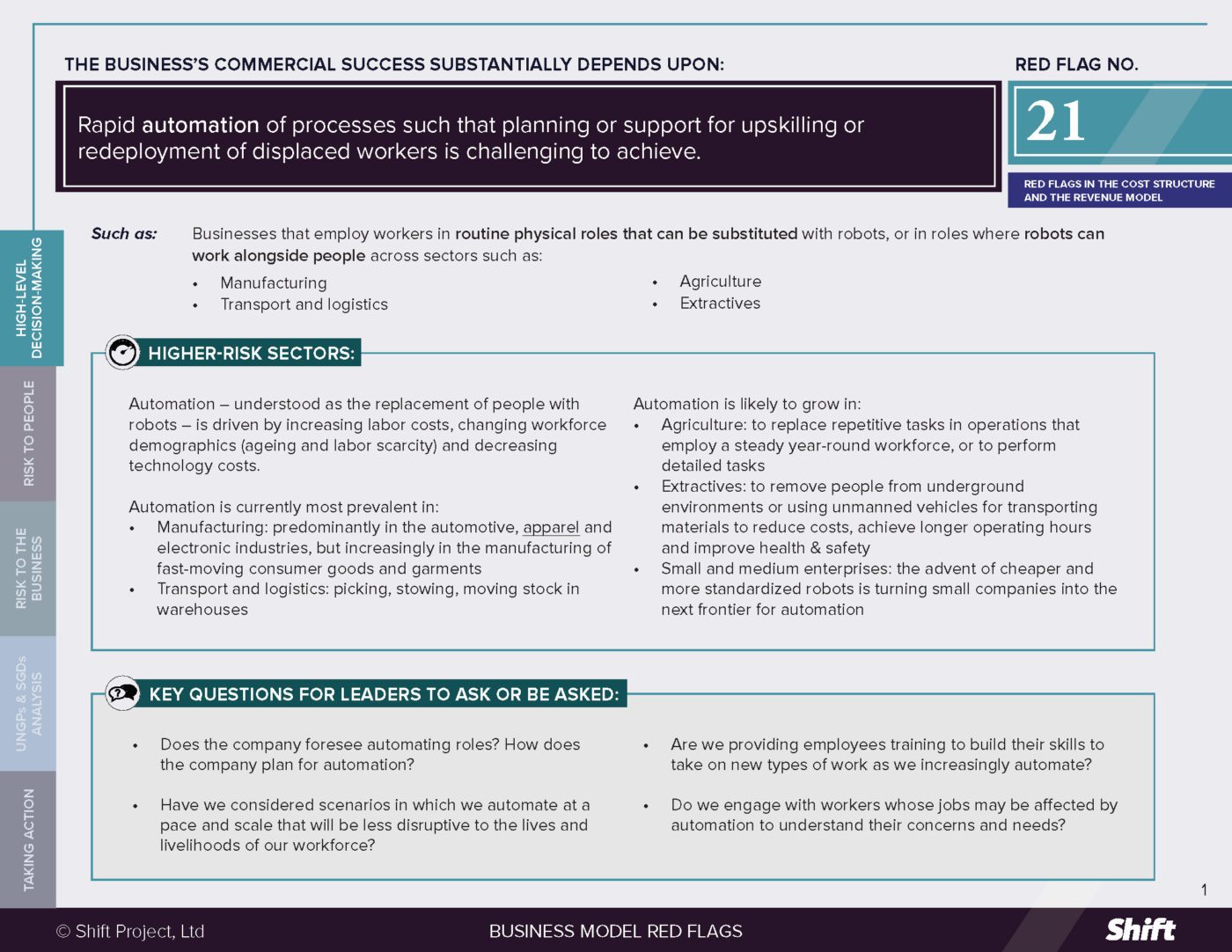RED FLAG # 12
Land use in countries in which ownership is often contested or records are unreliable or land users such as indigenous groups are unrecognized.
For Example
Relying on land use – including for extractive projects, the provision of commodities, or construction – in locations where:
- Indigenous peoples have traditional ownership or useof land
- ethnic/minority groups have historically been denied or dispossessed of formal land ownership rights
- women may not have access to legal land ownership
- owners of land may have been otherwise dispossessed or moved without consultation or adequate compensation
Higher-Risk Sectors
- Large-scale infrastructure (e.g. ports, roads, urban development)
- Telecommunications (e.g. phone and transmission lines; masts and towers)
- Energy (e.g. dams, wind farms, power plants)
- Extractives (e.g. mines, oil and gas installations, pipelines)
- Forestry (e.g. timber extraction, pulp and paper)
- Industrial farming (e.g. crops, livestock, irrigation projects,)
- Tourism (e.g. resort areas)
Questions for Leaders
- How does the company confirm that the land acquisitions or use rights granted in higher risk geographies do not in fact infringe legal or traditional ownership or use rights?
- How does the company ensure that it does not participate in or benefit from improper forced relocations, and adequately compensates inhabitants in voluntary relocations?
- How does the company ensure that potentially impacted communities have access to safe and effective ways to raise land- related concerns with the company?
How to use this resource. ( Click on the “+” sign to expand each section. You can use the side menu to return to the full list of red flags, download this Red Flag as a PDF or share this resource. )
Understanding Risks and Opportunities
Risks to People
- As stated by the UN Office of the High Commissioner for Human Rights (OHCHR), “[l]and is not a mere commodity, but an essential element for the realization of many human rights.” As a source of livelihood and a strong element of indigenous peoples’ identities, land is a fundamental aspect of economic, social and cultural rights.
- Companies can be involved with negative impacts where they acquire land rights in geographies in which rights to land are contested, relying on assurances from sellers, whether governments or private individuals, without further due diligence to identify whether competing claims exist. Human Rights Watch released a detailed report documenting illegal land confiscation from farmers in Myanmar, some of which was sold to companies.
- Impacts on land rights, including those arising from corporate activities, affect people differently, with disproportionately negative effects on individuals and groups who are traditionally discriminated against and marginalized, including women, indigenous peoples, rural communities and small-scale farmers. Where tenure is insecure, business activities can inadvertently cause these groups to lose rights to lands and resources, triggering a range of negative social impacts.
- Rural Poor: “We don’t even have enough for a daily meal. When we were farmers, if we didn’t have any money, we could eat some corn or beans. But when we have no farm, we can’t eat.” – Farmer, 66, Myanmar, March 2017. For the rural poor, access to land is the most critical way to make a living. Farming lands, forests, water and fisheries are essential resources for the enjoyment of their right to an adequate standard of living, including the right to adequate food and nutrition, water, and sanitation.
- Indigenous People: Indigenous peoples have specific human rights to own, use, develop and control the lands, territories and resources that they possess by reason of traditional ownership or other traditional occupation or use, as well as those which they have otherwise acquired. In line with their land-related human rights, set out in the UN Declaration on the Rights of Indigenous Peoples, any project that affects their territories and resources should only be undertaken with their Free, Prior and Informed Consent (FPIC). The lack of recognition of indigenous peoples and of their land rights by some governments, a lack of proper land titling, and debates over what evidence demonstrates proper consultations and FPIC have led to the dispossession and forced evictions of indigenous peoples from their ancestral lands.
- Women: Women also face severe challenges regarding access, use and ownership over land and its resources in many regions, with statistics showing that women are less likely to own or control land than men. Discrimination in inheritance, and/or the lack of proper land tenure and control can affect women’s livelihoods, food security, economic independence and physical security, making them more vulnerable to poverty, hunger, gender-based violence and displacement.
- Ethnic Minorities: Ethnic minorities are disproportionately affected by low access to and ownership of land, often because of wider societal discrimination. “Land grabbing” is compounding the vulnerability of minorities.
- Land-related conflicts are getting more violent. In 2018, an average of more than three land defenders were murdered every week, with half of the killings linked to mining, oil extraction and logging.
- The BHRRC has noted that while indigenous peoples are “among the first and worst affected by climate change,” and there are important indigenous-led initiatives for sustainable development and a just transition to low-carbon economies, at the same time “there is a growing resistance to large renewable energy projects among many indigenous communities.” The BHRRC has observed a “troubling trend” of an increase in allegations of displacement, harm to livelihoods, and violence against communities since 2010 with respect to renewable energy projects. BHRRC outreach to 50 wind and hydropower companies around the world revealed that most renewable energy firms do not yet have adequate due diligence practices –including identifying whether a project will impact indigenous peoples and reaching consent prior to the start of a project – to prevent human rights abuse.
Risks to the Business
Operational, Reputational and Financial Risks: Research shows that company-community conflicts may generate the same broad impacts on companies as technical problems, contractual or regulatory disputes, or environmental or safety breakdowns, although they typically do not receive equivalent attention or resources. Protests, blockades, property damage, public campaigns can lead to increased staff time on crisis management, lost productivity and value, work stoppages, project suspension or abandonment, that all increase costs for the business, including through the loss of future opportunities. For a world-class mining project, community conflict will cost roughly US$20 million per week of delayed production.
- The Belo Monte dam operations in Brazil were delayed and the hydropower plant’s license was suspended in 2016 because operators failed to compensate local communities. Similarly, the social impact investing firm AgDevCo faced substantial delays in the development of a large irrigated farm in Ghana because the company was unaware of a long-standing land boundary dispute between two ethnic groups who claimed rights over the area.
- Violent protests erupted in Argentina after the disappearance of a land rights activist who was fighting the eviction of Mapuche people from lands owned by the Italian company Benetton. After acquiring the land, the company fenced off over one million hectares and refused to let the indigenous group use the land for sheep grazing.
- In the Niger Delta, decades of conflict and reputation-damaging lawsuits over the failure to address the concerns of communities have led to the loss of access to their oil concessions for some companies, with facilities regularly sabotaged or attacked and production drastically falling.
Legal and Regulatory Risks: Companies acquiring or using land that results in communities getting displaced expose themselves to lawsuits and formal complaints. For example:
- 3,000 Cambodian farmers filed a class-action lawsuit against the Thai sugar group Mitr Phol accusing it of violently displacing the community to make way for plantations.
- ANZ Royal Bank’s human rights due diligence was found to be lacking by the Australian OECD National Contact Point after it provided a USD 40 million loan to the Phnom Penh Sugar Company in Cambodia. The loan was given a green light despite accusations of forced evictions, military-backed land grabbing, arbitrary arrests and intimidation against community members involved in land disputes.
- Canadian mining giant Hudbay is being sued by a group of Guatemalan women that alleged that the company and its subsidiary were complicit in the gang rapes they suffered at the hands of security personnel. The women are part of the Mayan Q’eqchi’ community which never accepted the legitimacy of the mining concession on their ancestral lands.
What the UN guiding principles say
*For an explanation of how companies can be involved in human rights impacts, and their related responsibilities, see here.
A company may contribute to negative impacts where it acquires land from a State or a third party in circumstances in which it is, or should be, aware that there may be competing claims to the land and does not conduct proper due diligence to investigate land ownership and consult with affected groups. It may also contribute to impacts where it makes it more difficult or impossible for the rightful owners to access and benefit from the acquired land.
A company may cause impacts where it fails to conduct resettlement processes in line with human rights standards and due process, including the use of excessive force to remove people from land it has acquired. It could also cause negative impacts on people’s human rights where it fails to provide adequate remedy for any damage to land, property, water access and quality, or land-based livelihoods resulting from its activities.
Companies downstream of land usage in their supply chain may be linked to land-related impacts by way of their products or services. For example, a company in the food and beverage industry that purchases agricultural commodities through a food processing company, or directly from a sugar grower or other agricultural company, may be linked to land related abuses occurring at source. Moreover, linkage may occur when a company acquires or uses disputed land despite having taken reasonable measures to verify that the land titles were fully legitimate and not the result of dispossession or any other type of denial of ownership by rightful communities.
In cases of linkage, once the company becomes aware of the claims, it may move into a situation of contribution over time if it takes no action to investigate and/or address the impact.
Possible Contributions to the SDGs
According to the Voluntary Guidelines on the Governance of Tenure, published by the UN FAO, securing land tenure rights and ensuring responsible land governance is key to achieving the SDGs. Addressing impacts to people associated with this red flag can contribute to, inter alia:
SDG 1: End poverty in all its forms everywhere, in particular: Target 1.4 By 2030, ensure that all men and women, in particular the poor and the vulnerable, have equal rights to economic resources, as well as access to basic services, ownership and control over land and other forms of property, inheritance, natural resources, appropriate new technology and financial services, including microfinance
SDG 2: End hunger, achieve food security and improved nutrition, and promote sustainable agriculture, in particular Target 2.3 By 2030, double the agricultural productivity and incomes of small-scale food producers, in particular women, indigenous peoples, family farmers, pastoralists and fishers, including through secure and equal access to land, other productive resources and inputs, knowledge, financial services, markets and opportunities for value addition and non-farm employment
SDG 5: Achieve gender equality and empower all women and girls, in particular Target 5.a.1. Proportion of total agricultural population with ownership or secure rights over agricultural land, by sex; (b) Share of women among owners or rights-bearers of agricultural land, by type of tenure. Target 5.a.2. Proportion of countries where the legal framework (including customary law) guarantees women’s equal rights to land ownership and/or control.
Taking Action
Due Diligence Lines of Inquiry
Due Diligence Lines of Inquiry adapted from the Danish Institute for Human Rights’ Human Rights Compliance Assessment Quick Check.
- Are the State policies and laws that ensure tenure rights non-discriminatory and gender sensitive? Does the State ensure equal tenure rights for women and men, including the right to inherit and pass on these rights?
- Does the State recognize as indigenous any groups that claim indigenous status and does it recognize indigenous people’s rights with regard to land, as set out in the Declaration on the Rights of Indigenous peoples?
- Before purchasing land, did we investigate all existing claims and conflicts and consult with all affected parties, including both legal and customary owners, and if indigenous peoples are involved, did we obtain their free, prior and informed consent?
- Considering that government maps do not always accurately reflect the traditional land usage of indigenous peoples, are we verifying this information, such as with the help of a person with deep expertise in and understanding of indigenous cultures and local tenure arrangements?
- When purchasing or leasing property from governments or large- scale land owners, did we investigate past occupation of the land to ensure that no forced relocations had been performed, unless done in conformity with international standards?
- Do we conduct due diligence with regard to the ownership and usage of land from which we derive key commodities or services through our supply chain, where such land is in regions with weak protections for traditional land rights or a history of land- related conflicts?
- Do we ensure that we do not participate in or benefit from improper forced relocations, and that we adequately compensate inhabitants involved in voluntary relocations?
- Does the company honor the rights of local or indigenous peoples on company-controlled land?
- Are our employees and security personnel trained to interact appropriately with indigenous and other local communities, allowing safe and unimpeded use of the land and its resources without harassment or intimidation?
- Do we have on-going processes in place to engage with local communities in order to understand any land-related impacts that may arise from our activities? Are we confident that local communities – women as well as men – feel able to raise issues with the company as part of those dialogues?
- Does the company have a broader community engagement or indigenous people’s policy and process, which includes the principle of Free, Prior and Informed Consent?
- Do we have processes in place to integrate issues raised by communities into company decision-making in a timely fashion?
- Does the State provide access to impartial and competent judicial and administrative bodies to resolve disputes over tenure rights, including effective remedies where appropriate?
- Do we have mechanisms for hearing, processing, and settling any grievances of local communities? How confident are we that communities trust those mechanisms and feel able to use them in practice?
Mitigation Examples
*Mitigation examples are current or historical examples for reference, but do not offer insight into their relative maturity or effectiveness.
- There are a growing number of examples of multi- stakeholder collaboration to tackle systemic risks related to land. For example, Illovo Sugar Africa, the largest sugar producer in Africa and subsidiary of AB Sugar in the UK, has come together with NGOs, governments and global donors to improve land tenure rights in the countries where it operates. The Maragra project, based around a plantation in Mozambique, targeted about 1,600 farmers to “make them more aware of their rights under Mozambique’s land laws; recorded the rights of smallholder farmers through a process of community land mapping; and created a robust grievance mechanism for farmers and the local community.”
- B2 Gold identified resettlement is a salient issue at its Fekola mine in Mali, specifically the potential for lost access or rights to land, or disruption to livelihoods. It developed a Resettlement Action Plan (RAP) and a resettlement-specific ESIA. The company established a community grievance mechanism with appeal available to a multi-stakeholder Resettlement Committee and further appeal to regional government development committee. The option to pursue the complaint through the formal legal system was available to complainants throughout. B2Gold reported that themechanism allowed it to “adjust and improve its approach throughout the resettlement process.”
- Establishing conflict resolution mechanisms and properly addressing competing claims to the land can help counter- balance the often unfair or inadequate procedures that allow commercial interests or the local privileged to prevent community land claims from being formalized.
- Instead of or in addition to social investments in schools and/or health facilities, “practitioners are stressing the importance of an “intelligent” community relations spend that focuses on hiring the right staff who are committed to building the kinds of relationships with local communities that prevent and mitigate the risk of conflict.” (See Costs of Conflict and Getting it Right: Making Corporate-Community Relations Work).
- ‘Front-end loading’ a budget for community relations to help address social risks provides an opportunity for the community relations function to influence the risk picture of the project as a whole.” (Also see Costs of Conflict).
Alternative Models
- Some of the alternative models that companies have explored are joint land ownership between communities and companies, as well as options for combining lease and profit-sharing. Land management contracts that prioritize profit-sharing may be an improvement on flat-rate leases. Outgrower arrangements can function as a method of compensation or an alternative to outright land purchase or lease; Landesa offers various resources including a review of best practices literature.
- Land-based joint-ventures may encourage entry into more competitive commercial agriculture by disadvantaged smallholders and community landowners. However, strong support is needed to ensure their capacity to make business decisions and realize sufficiently near-term returns or livelihood benefits. Canada offers several examples of joint ventures between First Nations businesses and logging companies. See this guide on benefit sharing agreements written for indigenous peoples, businesses and governments.
Other Tools and resources
Guidance for Companies
- Landesa Business Enterprise Supporting Materials.
- Shift (2018) The Human Rights Opportunity: Land Rights.
- The Indigenous Peoples Major Group, with contributions from the Danish Institute for Human Rights (2018) Doing it right! Sustainable Energy and Indigenous Peoples.
- Business Guide to the UNDRIP (2013) UN Global Compact.
- UN Food and Agriculture Organization (FAO) (2014) Respecting Free, Prior and Informed Consent: Practical Guidance forGovernments, Companies, NGOs, Indigenous Peoples and Local Communities in Relation to Land Acquisition, Governance of Tenure Technical Guide No. 3.
Key Standards
- UN Declaration on the Rights of Indigenous Peoples.
- IFC (2012) Performance Standard 5, Land Acquisition and Involuntary Resettlement.
- UN Office of the High Commissioner for Human Rights (2007) Basic Principles and Guidelines on Development Based Evictions and Displacements (Annex 1 of the report of the Special Rapporteur on adequate housing as a component of the right to an adequate standard of living).
- UN OHCHR (2015) Land and Human Rights: Standards and Applications, HR/PUB/15/5/Add.
- UN FAO (2012) Voluntary Guidelines on the Responsible Governance of Tenure of Land, Fisheries and Forests in the Context of National Food Security.
Other Useful Materials
- Global Reporting Initiative (2016) Land Tenure Rights.
- CORE and Womankind Worldwide (2017) Land Intensive Corporate Activity: The Impact on Women’s Rights.
- LandLinks Fact Sheet: Land Tenure and Women’s Empowerment.
- Rights and Resources Initiative (2015) Who Owns the Land? – A global baseline of formally recognized indigenous and communityland rights.

 Business Model Red Flags
Business Model Red Flags  Tool for Indicator Design
Tool for Indicator Design 